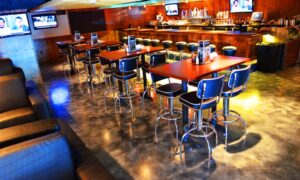Core Features Every Restaurant POS System Needs
In 2025, running a successful restaurant hinges on a solid foundation of essential POS features. These key components ensure smooth daily operations and can make or break your restaurant’s ability to grow and adapt. Understanding what is a POS and how it functions helps in making the right choice.
Cloud-Based Technology
Cloud-based restaurant POS systems are transforming restaurant operations with real-time access, automatic updates, and remote management. Instead of relying on clunky local servers, these systems store data securely off-site and reduce IT costs. For example, a sushi chain can update menus across all locations from one dashboard, saving time and hassle. During a power outage, a dim sum restaurant avoided losing sales records thanks to cloud backup. From inventory tracking to order management, restaurant software powered by the cloud keeps everything connected and running smoothly, no matter where you are. It’s the smart choice for modern, multi-location, and growing restaurants.
Integrated Payment Processing
Integrated payment processing connects your point of sale systems with payment systems, speeding up transactions while boosting accuracy and security. No manual entry means fewer mistakes, while encryption and PCI compliance keep customer data safe. Bars like Drink in Boston use card preauthorization to open secure tabs, linking names to orders and reducing wait times. These systems sync payments in real time, making reconciliation easier. With nearly 60% of guests preferring contactless payments, restaurant POS software must support everything from credit cards to mobile wallets, ensuring fast, flexible, and secure checkouts that meet today’s customer expectations.
POS Features That Improve Customer Experience
Beyond handling the basics, a point of sale system with customer-focused features can turn casual diners into loyal regulars. These tools go beyond core operations, enhancing the overall dining experience and making customers feel valued.
Loyalty and Rewards Programs
Loyalty programs integrated into your POS system are a game-changer for customer retention. These systems automatically track purchases, assign points, and notify customers about rewards—all in real time. This seamless process encourages repeat visits and builds stronger customer relationships. The numbers speak for themselves: businesses see a 35% boost in sales, 73% of customers recommending them to others, and 67% higher spending from loyal guests. Major brands like Starbucks, Chick-fil-A, and Dunkin’ show how real-time reward tracking and personalized offers can create a loyalty ecosystem that keeps customers coming back. For multi-concept operators, unified loyalty platforms simplify managing orders, reservations, and rewards across different locations. Ease of use is critical. Customers are more likely to participate when enrollment is simple, and 64% of loyalty members spend more per transaction to earn additional points. Some restaurant POS systems even integrate rewards directly into checkouts for convenience.
Multi-Channel Order Management
Customers today want options, whether dining in, picking up, or ordering for delivery. Flexibility is now a need rather than a luxury. By 2025, mobile orders are expected to account for over 60% of all digital restaurant transactions. A unified order management system ties all these channels together, ensuring accuracy and reducing errors. Multi-channel restaurants claim 15–20% higher order frequency and client retention. Take Panera’s MyPanera program, for example. It allows customers to earn and redeem rewards no matter how they place their orders, whether in-store, via a mobile app, or on a website, providing a consistent and seamless experience. Such systems streamline operations by automating order processing, reducing manual entry, and minimizing mistakes. A POS demo can showcase how restaurant software supports real-time inventory tracking, ensuring customers aren’t disappointed by unavailable items, while integrated payment processing keeps checkout smooth across all channels. With over 60% of U.S. consumers ordering delivery or takeout weekly, avoiding errors is crucial, especially since the average restaurant loses 2% of sales due to POS-related issues.
Analytics and Reporting for Better Business Decisions
In 2025, data is king. Modern restaurant POS software offers powerful analytics to help restaurants make smarter decisions. Real-time tracking, sales trends, and Restaurant Inventory Software reports replace guesswork with data-backed strategies. Operators can pinpoint peak hours, best-selling items, and cost-saving opportunities with ease. These insights directly impact profitability and efficiency. POS systems are essential for performance management in addition to transactions. By turning raw data into meaningful reports, restaurants gain clarity, agility, and a competitive advantage. It’s not about working harder; it’s about working smarter through informed, data-driven decisions that improve operations across the board.
Customizable Profitability Dashboards
Live dashboards give restaurant owners real-time visibility into their business. Metrics like labor costs, food waste, and menu item performance are tracked continuously, helping managers make instant, informed decisions. Customization ensures focus on what matters most, whether it’s optimizing staffing, improving pricing, or rewarding high-performing staff. Dashboards help refine operations without guesswork, making data accessible and actionable. They also support strategic menu engineering based on actual profit margins. Combined with AI tools, dashboards enable predictive insights, helping restaurants stay ahead of the curve. It’s all about turning complex data into smart moves that drive growth and efficiency using restaurant software that adapts with you.
AI-Powered Forecasting
With up to 98% accuracy in demand forecasting, AI is revolutionizing restaurant operations. These tools analyze past sales, weather, events, and customer behavior to predict needs, reduce waste, and cut labor costs. For example, restaurants using AI have boosted sales per labor hour and reduced scheduling inefficiencies. AI also adapts in real time, keeping forecasts accurate despite sudden changes. Seamless integration with your bar POS system and user-friendly design are key when choosing a tool. The result? Smarter planning, better service, and higher profits, all with less manual work. AI turns unprocessed data into proactive actions that increase profits.
Choosing a POS System That Expands With Your Business
A scalable POS system evolves with your restaurant. Whether you’re opening new locations, expanding services, or adopting new tech, the right point of sale system supports growth without frequent upgrades. With customizable features, flexible pricing, and modular add-ons, scalable systems grow at your pace. In fact, 76% of restaurant owners see tech as a competitive edge. A future-ready restaurant software solution enables smooth operations, improves customer experience, and saves money by avoiding unnecessary tools. Investing in a scalable POS ensures you’re equipped for both today’s demands and tomorrow’s opportunities, making it essential for long-term restaurant success.
Multi-Location Management
Managing multiple restaurants is easier with a POS that centralizes operations. A cloud-based system lets you control menus, track sales, and schedule staff across all sites from one platform. Changes at one location update everywhere, ensuring brand consistency. Real-time analytics reveal sales trends and customer preferences chain-wide, empowering smarter decisions. For busy operators, this means less admin work and more time improving service. From bulk inventory orders to unified promotions, centralized control simplifies growth. Whether you manage two spots or twenty, a multi-location bar POS system ensures efficiency, accuracy, and a seamless customer experience at every touchpoint.
Custom Integrations and APIs
POS systems with open APIs and integrations keep your restaurant connected and future-ready. These systems link with tools like online ordering, loyalty programs, delivery platforms, and payment processors, streamlining workflows and enhancing guest experiences. For example, a burger chain automated delivery input through POS integration, cutting errors and boosting kitchen speed. As tech evolves, integrations help you stay competitive without switching platforms. Choose solutions that meet regulatory standards and scale with your business. Whether through native apps, middleware, or custom APIs, integrations ensure your Restaurant Inventory Software and POS work together to support growth with minimal friction.
Conclusion: Making the Right POS Choice for Your Restaurant in 2025
Choosing the right POS system in 2025 is critical to staying competitive. With digital ordering set to hit $90.3B by 2030 and cloud POS adoption rapidly rising, investing in the right solution means aligning features with your unique operational needs. Look for restaurant POS systems offering fast transactions, real-time inventory tracking, and support for EMV, NFC, mobile wallets, and loyalty programs. Integration with third-party tools, 24/7 local support, and hands-on training are essential for smooth implementation. Don’t overlook costs; evaluate hardware, software, and ongoing fees to avoid budget surprises. Smart POS choices can reduce labor costs by up to $8,000 monthly and increase growth by 25%. Ensure your system adapts to trends like AI analytics and contactless tech. Perform regular maintenance and updates to keep it running efficiently. Your POS system isn’t just a backend tool—it’s a powerful driver of growth, efficiency, and customer satisfaction in today’s tech-first restaurant landscape. Know what is a POS and how it can future-proof your success.



































